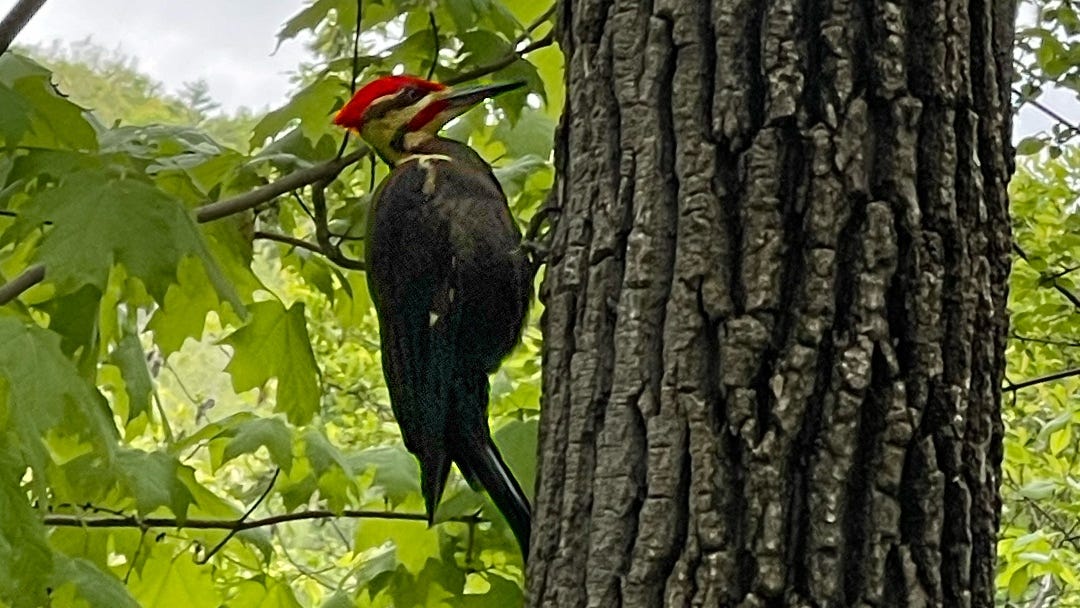Why Woodpeckers Don't Develop a Splitting Headache
Birds, beauty, and inspiration in challenging times

Some years ago, in a forest not far from Ottawa, I watched as a pileated woodpecker—nearly the size of a crow—worked methodically at the bark of a maple tree, its flaming red crest blazing against the wood. I captured its fanatic hammering, powerful neck movements, and precise strikes for twelve seconds.
The footage is brief, but it sparked a fascination that led me to learn more about these magnificent birds. I've seen quite a few of them since, but none quite like this one, which worked just meters away, seemingly undisturbed by my presence.
The pileated woodpecker I filmed that day was likely searching for carpenter ants, which can make up nearly all of its diet. These birds are ecosystem engineers—their rectangular excavations create homes for other species, their feeding activity controls insect populations, and their abandoned nests become nurseries for other birds. They may be loud, but that doesn't mean they are the neighborhood bully. Instead, they contribute to the larger community; strength often lies in supporting the networks we're part of.
My admiration deepened when I learned about the remarkable engineering that allows these birds to strike wood up to twenty times per second without injury. I wondered why these persistent hammerers didn't develop splitting headaches and discovered their secret: a specialized hyoid bone that wraps around their brain like a natural seat belt, cushioning it against impact. Nature required them to buckle up long before we did.
In my work on climate change, which focuses on how our societies must adapt, I've often ventured into a related path: how animals and plants evolve to survive changing environments. I've learned about moths' camouflage, bats' sonar, and butterflies' migration patterns. But the woodpecker's design strikes me as particularly relevant to our times. In an era where we're increasingly concerned about brain injuries in sports and accidents, this bird has demonstrated the perfect protective system for millions of years.
Scientists studying the pileated woodpecker found that the bird's upper beak extends slightly beyond the lower, a design feature that helps distribute impact forces away from the skull. Evolution has crafted every aspect of this creature for both efficiency and protection. These insights from woodpecker anatomy inspire human technology, particularly in developing better protective gear for athletes and soldiers.
While studying these remarkable birds, I discovered another fascinating aspect of their lives that reminded me of a recent Note I wrote about swans: pileated woodpeckers form lasting partnerships just as swans do. They stay with the same partner through all seasons and maintain their territory year-round, combining physical resilience with social stability. Their cognitive abilities are equally impressive - despite having a brain 700 times smaller than a human's, they process information with incredible precision. Sometimes, less can be more.
The twelve seconds I captured tell only a fraction of the story. They don't show the specialized plate-like bones in the skull that distribute impact forces or the bird's millisecond adjustments with each strike. They don't reveal how the woodpecker's brain is positioned to dissipate energy across its surface rather than concentrating it in one spot. Yet this brief encounter captures something profound about resilience.
For all those who feel overwhelmed by daily challenges right now, nature offers tested wisdom. Like the woodpecker, we can learn to distribute the impact of each blow, face our obstacles methodically, and find the weak spots in what seems impenetrable. The lesson isn't just about protecting ourselves against impact—it's about persistence, adaptation, and finding strength in precision rather than force to pierce holes into something that looks too large to defeat.
Here is one more video of a Pileated woodpecker overdoing it a bit (📹 wordbirds32):



Informative and delightful! The things we can learn from nature when we pay attention :)
Back in the days of Acid Rain in Ontario, the forests experienced "maple die-back" . The tops of young maples would die leaving the wood susceptible to insect invasion. The population of Pileateds grew as their food supply increased. They protected those trees and others from those insects. The numbers have receded a bit, but it's still quite common to hear them "managing their forest".